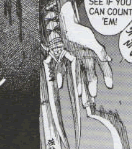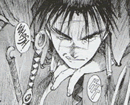|
So much of
Japanese history centers on the legendary warrior class known as
samurai that it is no wonder that there is a great deal of Japanese
animation about these warriors and their lives.
What
is a Samurai?
Samurai literally
means "those who serve." Samurai comprised the warrior
class of ancient Japan. However, to be a samurai isn't simply to
be a fighter - a samurai is a man of honor, the backbone of the
military, and a member of the aristocracy. Samurai were versatile
warriors, court officials, and disguised assassins. In fact, this
dual role of warrior and administrator is often cause for comparison
between medieval European knights and feudal Japanese samurai.
Samurai
Honor
Samurai were
bound by honor and codes of ethics that may seem strange to Westerners.
They swore absolute fealty to their masters, and would willingly
die on command. Arguably, this is what made them so effective. In
addition, if they failed their master, or brought shame upon his
house, they could voluntarily (or upon orders) commit ritual suicide.
Odago Koinosuke,
an ancient samurai, in the anime Jubei-chan,
demonstrates this sort of behavior. Upon his deathbed, Odago's master
give him the quest to carry on the legacy of a great school of Japanese
swordsmanship, no matter how long it took to find a worthy successor.
After hundreds of years of searching, Odago Koinosuke finds Nanohana
Jiyu, a cute high school girl who fits the description given to
him by his master. Being a traditional samurai, Odago acts in ways
that are strange and upsetting to Jiyu. For instance, as Jiyu is
his new master, Odago refers to her with the -dono Japanese suffix,
which is an honorific used by samurai and nobles to express high
respect. Also, at one point in the series, Koinosuke almost commits
ritual suicide when Jiyu falls ill. Overall, he is very dramatic
in everything he does, which adds a comedic element to the series
by caricaturizing samurai court custom.
Samurai
Combat Arts
These warriors
were the masters of the art of war. They were foot soldiers, cavalrymen,
archers, and silent assassins. Within the frame of bujutsu,
they specialized in over 60 armed and unarmed disciplines, ranging
from swordsmanship and archery, to armed combat with fans and chains.
Furthermore, bujutsu encompasses arts of swimming, horse riding,
spying, and over 20 forms of unarmed combat.
One shining
example of the different arts used by samurai is the manga
Blade of the Immortal by Samura Hiroaki. One of the main
characters, Manji, carries twelve samurai weapons on his person
at all times. In addition, he practices several forms of both armed
and unarmed combat, utilizing weapons such as katana,
wakizashi,
tanto,
jitte,
kusari-gama,
and nunchaku.
Samurai
Movement
One of a samurai's
greatest strengths is his speed and agility. Many of the combat
arts relied on quick dodging, evasion, and turning, in order to
defeat multiple opponents at once. In addition, samurai practicing
the occult art of ninjutsu had to rely on stealth, silent running,
and cloak-and-dagger tactics in order to carry out their missions.
Often, these ninja would sneak deep into the compounds of enemy
officials and execute them, leaving without a trace or a footprint.
In addition to stealth, samurai were trained in swimming while wearing
armor, and fighting on horseback. Examples of the way samurai move
can be seen in the Rurouni Kenshin (also known as Samurai
X)
OVAs.
Samurai
Customs
One of the
most famous customs is that of seppuku, or ritual suicide. Seppuku
is carried out by cutting into and disemboweling one's own abdomen.
This gruesome feat was usually required of a samurai who had done
something dishonorable, such as insulting someone of higher rank
than himself.
Another interesting
custom of the samurai involved using ordinary objects as weapons.
In some settings, such as that of a superior officer, samurai were
not allowed to carry a sword. Not wanting to go unarmed, samurai
would equip themselves with fans or pipes - ordinary objects that
could be used in deadly combat. There are many accounts of deaths
resulting from blows from folded fans or metal pipes.
Conclusion
Samurai were
experts in the art of combat - both armed and unarmed, using traditional
weapons or everyday objects. These men were not simply warriors:
they were court officials, assassins in the night, and honorable
men ready to leap to their deaths in defense or revenge of their
master.
-Eric Goldberg 
References
Oscar Ratti
/ Adele Westbrook, Secrets of the Samurai, Castle Books,
1999
Stephen R.
Turnbull, The Book of the Samurai: The Warrior Class of Japan,
Arms and Armour Press, 1982
Samurai
X
Blade of the Immortal
Jubei-chan
|
|

|
|
Manji from
Blade of the Immortal brandishes his weapons.
|
|

|
|
Manji draws
a jitte on his adversary.
|
|

|
|
"I'm
not finished with you yet."
|
|















